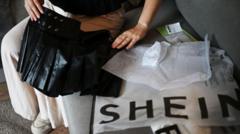Forever 21 is taking significant steps toward potential closure in the U.S. market following its operating company's filing for bankruptcy protection. In a recent statement, Forever 21 confirmed that while it begins the "process of winding down," its stores and online shopping platform in the U.S. will continue to operate.
The fashion retailer was once a staple for trendy, affordable clothing for younger shoppers, but in recent years, it has faced challenges luring customers due to escalating costs and the shift toward online retail. This is not the first time Forever 21 has encountered financial troubles; the company previously filed for bankruptcy protection in 2019, only to be acquired by a group of investors through a joint venture shortly thereafter.
CFO Brad Sell noted, "We have been unable to find a sustainable path forward, given competition from foreign fast-fashion companies... as well as rising costs, economic challenges impacting our core customers." As part of its reorganization efforts, the firm plans to initiate liquidation sales at various store locations, with some assets potentially up for sale in a court-managed process. The company suggested that a successful sale could lead to a reevaluation of their operational wind-down strategy.
Under Chapter 11 protection, U.S. companies can effectively defer their obligations to creditors, allowing them time to reorganize debts or sell off different aspects of their business. Notably, Forever 21's international retail operations are unaffected by this filing as they are managed by separate license-holders.
Founded in Los Angeles in 1984 by South Korean immigrants, Forever 21 gained immense popularity due to its trendy and affordable offerings. At its pinnacle in 2016, the brand boasted 800 stores globally, with 500 located across the U.S. However, the culmination of fierce competition from fast-fashion leaders like Zara and H&M, coupled with changing consumer spending habits, has led the retailer to this precarious situation.
The fashion retailer was once a staple for trendy, affordable clothing for younger shoppers, but in recent years, it has faced challenges luring customers due to escalating costs and the shift toward online retail. This is not the first time Forever 21 has encountered financial troubles; the company previously filed for bankruptcy protection in 2019, only to be acquired by a group of investors through a joint venture shortly thereafter.
CFO Brad Sell noted, "We have been unable to find a sustainable path forward, given competition from foreign fast-fashion companies... as well as rising costs, economic challenges impacting our core customers." As part of its reorganization efforts, the firm plans to initiate liquidation sales at various store locations, with some assets potentially up for sale in a court-managed process. The company suggested that a successful sale could lead to a reevaluation of their operational wind-down strategy.
Under Chapter 11 protection, U.S. companies can effectively defer their obligations to creditors, allowing them time to reorganize debts or sell off different aspects of their business. Notably, Forever 21's international retail operations are unaffected by this filing as they are managed by separate license-holders.
Founded in Los Angeles in 1984 by South Korean immigrants, Forever 21 gained immense popularity due to its trendy and affordable offerings. At its pinnacle in 2016, the brand boasted 800 stores globally, with 500 located across the U.S. However, the culmination of fierce competition from fast-fashion leaders like Zara and H&M, coupled with changing consumer spending habits, has led the retailer to this precarious situation.






















